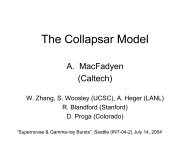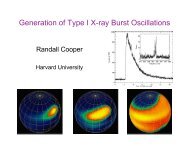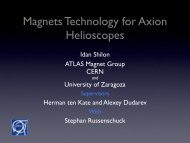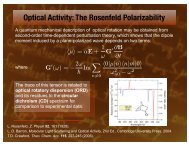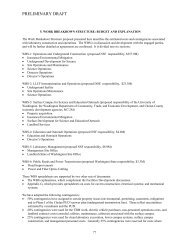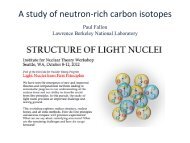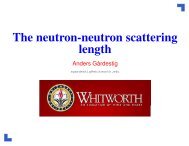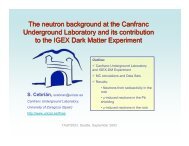Astrophysical and Cosmological Axion Limits - INT Home Page
Astrophysical and Cosmological Axion Limits - INT Home Page
Astrophysical and Cosmological Axion Limits - INT Home Page
You also want an ePaper? Increase the reach of your titles
YUMPU automatically turns print PDFs into web optimized ePapers that Google loves.
Sun Globular Cluster Supernova 1987A Dark Matter<br />
<strong>Astrophysical</strong> <strong>and</strong> <strong>Cosmological</strong><br />
<strong>Axion</strong> <strong>Limits</strong><br />
Georg G. Raffelt, Max-Planck-Institut für Physik, München<br />
Georg Raffelt, MPI Physics, Munich Vistas in <strong>Axion</strong> Physics, <strong>INT</strong>, Seattle, 23–26 April 2012
Sun<br />
Solar <strong>Axion</strong>s<br />
Globular Cluster Supernova 1987A Dark Matter<br />
Georg Raffelt, MPI Physics, Munich Vistas in <strong>Axion</strong> Physics, <strong>INT</strong>, Seattle, 23–26 April 2012
γ<br />
Primakoff<br />
production<br />
Sun<br />
Search for Solar <strong>Axion</strong>s<br />
a<br />
<strong>Axion</strong> flux<br />
a<br />
<strong>Axion</strong> Helioscope<br />
(Sikivie 1983)<br />
Magnet S<br />
<strong>Axion</strong>-Photon-Oscillation<br />
Georg Raffelt, MPI Physics, Munich Vistas in <strong>Axion</strong> Physics, <strong>INT</strong>, Seattle, 23–26 April 2012<br />
N<br />
� Tokyo <strong>Axion</strong> Helioscope (“Sumico”)<br />
(Results since 1998, up again 2008)<br />
� CERN <strong>Axion</strong> Solar Telescope (CAST)<br />
(Data since 2003)<br />
Alternative technique:<br />
Bragg conversion in crystal<br />
Experimental limits on solar axion flux<br />
from dark-matter experiments<br />
(SOLAX, COSME, DAMA, CDMS ...)<br />
γ
Georg Raffelt, MPI Physics, Munich Vistas in <strong>Axion</strong> Physics, <strong>INT</strong>, Seattle, 23–26 April 2012
Solar Neutrino Limit on Solar Energy Losses<br />
Self-consistent models of the present-day Sun provide a simple power-law connection<br />
between a new energy loss L a (e.g. axions) <strong>and</strong> the all-flavor solar neutrino flux from<br />
the B8 reaction as measured by SNO<br />
Schlattl, Weiss & Raffelt, hep-ph/9807476<br />
Gondolo & Raffelt, arXiv:0807.2926<br />
Georg Raffelt, MPI Physics, Munich Vistas in <strong>Axion</strong> Physics, <strong>INT</strong>, Seattle, 23–26 April 2012
LHC Magnet Mounted as a Telescope to Follow the Sun<br />
Georg Raffelt, MPI Physics, Munich Vistas in <strong>Axion</strong> Physics, <strong>INT</strong>, Seattle, 23–26 April 2012
Helioscope <strong>Limits</strong><br />
Solar neutrino<br />
limit<br />
First experimental<br />
crossing of the KSVZ line<br />
CAST-I results: PRL 94:121301 (2005) <strong>and</strong> JCAP 0704 (2007) 010<br />
CAST-II results (He-4 filling): JCAP 0902 (2009) 008<br />
CAST-II results (He-3 filling, range 1): PRL 107 (2011) 261302<br />
Georg Raffelt, MPI Physics, Munich Vistas in <strong>Axion</strong> Physics, <strong>INT</strong>, Seattle, 23–26 April 2012
Next Generation <strong>Axion</strong> Helioscope (IAXO)<br />
LLNL Design<br />
Irastorza et al., “Towards a new generation axion helioscope”, arXiv:1103.5334<br />
Georg Raffelt, MPI Physics, Munich Vistas in <strong>Axion</strong> Physics, <strong>INT</strong>, Seattle, 23–26 April 2012
Sun Supernova 1987A Dark Matter<br />
Globular Cluster<br />
<strong>Axion</strong>s from Normal Stars<br />
Georg Raffelt, MPI Physics, Munich Vistas in <strong>Axion</strong> Physics, <strong>INT</strong>, Seattle, 23–26 April 2012
Galactic Globular Cluster M55<br />
Georg Raffelt, MPI Physics, Munich Vistas in <strong>Axion</strong> Physics, <strong>INT</strong>, Seattle, 23–26 April 2012
Color-Magnitude Diagram for Globular Clusters<br />
H<br />
He<br />
C O<br />
Asymptotic Giant<br />
H<br />
He<br />
Horizontal Branch<br />
C O White<br />
Dwarfs<br />
Hot, blue cold, red<br />
Color-magnitude diagram synthesized from several low-metallicity globular<br />
clusters <strong>and</strong> compared with theoretical isochrones (W.Harris, 2000)<br />
Georg Raffelt, MPI Physics, Munich Vistas in <strong>Axion</strong> Physics, <strong>INT</strong>, Seattle, 23–26 April 2012<br />
H<br />
He<br />
Red Giant<br />
H<br />
Main-Sequence
Color-Magnitude Diagram for Globular Clusters<br />
H<br />
He<br />
C O<br />
Asymptotic Giant<br />
H<br />
He Particle emission reduces<br />
helium burning lifetime,<br />
i.e. number of HB C stars O<br />
White<br />
Dwarfs<br />
Horizontal Branch<br />
• Particle emission delays<br />
helium ignition,<br />
• Tip of RGB brighter<br />
Hot, blue cold, red<br />
Color-magnitude diagram synthesized from several low-metallicity globular<br />
clusters <strong>and</strong> compared with theoretical isochrones (W.Harris, 2000)<br />
Georg Raffelt, MPI Physics, Munich Vistas in <strong>Axion</strong> Physics, <strong>INT</strong>, Seattle, 23–26 April 2012<br />
H<br />
He<br />
Red Giant<br />
H<br />
Main-Sequence
Parameter Space for <strong>Axion</strong>-Like Particles (ALPs)<br />
Invisible<br />
axion (DM)<br />
Georg Raffelt, MPI Physics, Munich Vistas in <strong>Axion</strong> Physics, <strong>INT</strong>, Seattle, 23–26 April 2012
Parameter Space for <strong>Axion</strong>-Like Particles<br />
Laser<br />
Experiments<br />
Invisible<br />
axion (DM)<br />
CAST<br />
Solar <strong>Axion</strong>s<br />
HB<br />
Stars<br />
Georg Raffelt, MPI Physics, Munich Vistas in <strong>Axion</strong> Physics, <strong>INT</strong>, Seattle, 23–26 April 2012
Shining TeV Gamma Rays through the Universe<br />
Figure from a talk by Manuel Meyer (Univ. Hamburg)<br />
Georg Raffelt, MPI Physics, Munich Vistas in <strong>Axion</strong> Physics, <strong>INT</strong>, Seattle, 23–26 April 2012
Shining TeV Gamma Rays through the Universe<br />
Figure from a talk by Manuel Meyer (Univ. Hamburg)<br />
Georg Raffelt, MPI Physics, Munich Vistas in <strong>Axion</strong> Physics, <strong>INT</strong>, Seattle, 23–26 April 2012
Parameter Space for <strong>Axion</strong>-Like Particles<br />
TeV γ rays<br />
Laser<br />
Experiments<br />
How to make<br />
progress?<br />
Invisible<br />
axion (DM)<br />
CAST<br />
Solar <strong>Axion</strong>s<br />
HB<br />
Stars<br />
Georg Raffelt, MPI Physics, Munich Vistas in <strong>Axion</strong> Physics, <strong>INT</strong>, Seattle, 23–26 April 2012
Sun Globular Cluster<br />
Dark Matter<br />
Supernova 1987A<br />
SN 1987A Neutrino Signal<br />
Georg Raffelt, MPI Physics, Munich Vistas in <strong>Axion</strong> Physics, <strong>INT</strong>, Seattle, 23–26 April 2012
S<strong>and</strong>uleak -69 202<br />
S<strong>and</strong>uleak −69 202 Supernova 1987A<br />
23 February 1987<br />
Georg Raffelt, MPI Physics, Munich Vistas in <strong>Axion</strong> Physics, <strong>INT</strong>, Seattle, 23–26 April 2012
Supernova 1987A Energy-Loss Argument<br />
SN 1987A neutrino signal<br />
Neutrino<br />
diffusion<br />
Neutrino<br />
sphere<br />
Volume emission<br />
of new particles<br />
Emission of very weakly interacting<br />
particles would “steal” energy from the<br />
neutrino burst <strong>and</strong> shorten it.<br />
(Early neutrino burst powered by accretion,<br />
not sensitive to volume energy loss.)<br />
Late-time signal most sensitive observable<br />
Georg Raffelt, MPI Physics, Munich Vistas in <strong>Axion</strong> Physics, <strong>INT</strong>, Seattle, 23–26 April 2012
N<br />
N<br />
<strong>Axion</strong> Emission from a Nuclear Medium<br />
V<br />
Nucleon-Nucleon<br />
Bremsstrahlung<br />
a<br />
N<br />
N<br />
+ ...<br />
Early calculations using one-pion exchange potential without many body effects or<br />
multiple-scattering effects over-estimated emission rate, see e.g.<br />
• Janka, Keil, Raffelt & Seckel, PRL 76:2621,1996.<br />
• Hanhart, Phillips & Reddy, PLB 499:9, 2001.<br />
• Bacca, Hally, Liebendörfer, Perego, Pethick & Schwenk, arXiv:1112.5185 (2011).<br />
Georg Raffelt, MPI Physics, Munich Vistas in <strong>Axion</strong> Physics, <strong>INT</strong>, Seattle, 23–26 April 2012
Cooling Time Scale<br />
Exponential cooling model: T = T 0 e −t/4τ , constant radius, L = L 0 e −t/τ<br />
Fit parameters are T 0, τ, radius, 3 offset times for KII, IMB & BST detectors<br />
Loredo <strong>and</strong> Lamb, Bayesian analysis<br />
astro-ph/0107260<br />
Georg Raffelt, MPI Physics, Munich Vistas in <strong>Axion</strong> Physics, <strong>INT</strong>, Seattle, 23–26 April 2012
Long-Term Cooling of EC SN (Garching 2009)<br />
Neutrino opacities without these effects<br />
(~ Basel case?)<br />
Much longer cooling times<br />
L. Hüdepohl et al. (Garching Group), arXiv:0912.0260<br />
Georg Raffelt, MPI Physics, Munich Vistas in <strong>Axion</strong> Physics, <strong>INT</strong>, Seattle, 23–26 April 2012
m a<br />
Experiments<br />
<strong>Axion</strong> Bounds <strong>and</strong> Searches<br />
10 3 10 6 10 9 10 12<br />
keV eV meV μeV<br />
Tele<br />
scope<br />
Too much<br />
hot dark matter<br />
Globular clusters<br />
(a-γ-coupling)<br />
SN 1987A<br />
Too many events<br />
CAST<br />
Too much<br />
energy loss<br />
Globular clusters (helium ignition)<br />
(a-e coupling)<br />
Direct<br />
searches<br />
ADMX<br />
(Seattle & Yale)<br />
[GeV] f a<br />
10 15<br />
neV<br />
Too much cold CDMdark<br />
matter<br />
(misalignment (misalignment) with Θi = 1)<br />
Georg Raffelt, MPI Physics, Munich Vistas in <strong>Axion</strong> Physics, <strong>INT</strong>, Seattle, 23–26 April 2012
m a<br />
Experiments<br />
<strong>Axion</strong> Bounds <strong>and</strong> Searches<br />
10 3 10 6 10 9 10 12<br />
keV eV meV μeV<br />
Tele<br />
scope<br />
Too much<br />
hot dark matter<br />
Globular clusters<br />
(a-γ-coupling)<br />
SN 1987A<br />
Too many events<br />
CAST<br />
Too much<br />
energy loss<br />
Globular clusters (helium ignition)<br />
(a-e coupling)<br />
White dwarf<br />
cooling?<br />
Direct<br />
searches<br />
ADMX<br />
(Seattle & Yale)<br />
[GeV] f a<br />
10 15<br />
neV<br />
Too much cold CDMdark<br />
matter<br />
(misalignment (misalignment) with Θi = 1)<br />
Georg Raffelt, MPI Physics, Munich Vistas in <strong>Axion</strong> Physics, <strong>INT</strong>, Seattle, 23–26 April 2012
Do White Dwarfs Need <strong>Axion</strong> Cooling?<br />
No axions<br />
White dwarf<br />
luminosity function<br />
(number of WDs per<br />
brightness interval)<br />
Isern et al.,<br />
arXiv:1204.3565<br />
Georg Raffelt, MPI Physics, Munich Vistas in <strong>Axion</strong> Physics, <strong>INT</strong>, Seattle, 23–26 April 2012
Diffuse Supernova <strong>Axion</strong> Background (DSAB)<br />
• Neutrinos from all core-collapse SNe comparable to photons from all stars<br />
• Diffuse Supernova Neutrino Background (DSNB) similar energy density as<br />
extra-galactic background light (EBL), approx 10% of CMB energy density<br />
• DSNB probably next astro neutrinos to be measured<br />
Raffelt, Redondo & Viaux<br />
work in progress (2011)<br />
Georg Raffelt, MPI Physics, Munich Vistas in <strong>Axion</strong> Physics, <strong>INT</strong>, Seattle, 23–26 April 2012
CP-Violating Forces<br />
bulk bulk bulk spin spin spin<br />
Georg Raffelt, MPI Physics, Munich Vistas in <strong>Axion</strong> Physics, <strong>INT</strong>, Seattle, 23–26 April 2012
Long-Range Force Experiments<br />
Long-range force limits from tests of<br />
Newton’s law <strong>and</strong> equivalence principle<br />
(Mostly from Eöt-Wash Group, Seattle)<br />
Torsion+astro<br />
Torsion<br />
(bulk-spin)<br />
bulk bulk bulk spin<br />
Georg Raffelt, MPI Physics, Munich Vistas in <strong>Axion</strong> Physics, <strong>INT</strong>, Seattle, 23–26 April 2012
<strong>Limits</strong> on CP Violation from Long-Range Forces<br />
Georg Raffelt, MPI Physics, Munich Vistas in <strong>Axion</strong> Physics, <strong>INT</strong>, Seattle, 23–26 April 2012
Sun Globular Cluster Supernova 1987A<br />
Dark Matter<br />
<strong>Cosmological</strong> Constraints<br />
Georg Raffelt, MPI Physics, Munich Vistas in <strong>Axion</strong> Physics, <strong>INT</strong>, Seattle, 23–26 April 2012
Lee-Weinberg Curve for Neutrinos <strong>and</strong> <strong>Axion</strong>s<br />
<strong>Axion</strong>s Non-Thermal<br />
Thermal Relics<br />
Relics<br />
Neutrinos<br />
& WIMPs<br />
10 μeV<br />
CDM HDM<br />
10 eV<br />
HDM<br />
10 eV<br />
Thermal Relics<br />
CDM<br />
10 GeV<br />
Georg Raffelt, MPI Physics, Munich Vistas in <strong>Axion</strong> Physics, <strong>INT</strong>, Seattle, 23–26 April 2012
π<br />
<strong>Axion</strong> Hot Dark Matter from Thermalization after Λ QCD<br />
π<br />
π a<br />
Chang & Choi, PLB 316 (1993) 51<br />
Hannestad, Mirizzi<br />
& Raffelt,<br />
hep-ph/0504059<br />
Georg Raffelt, MPI Physics, Munich Vistas in <strong>Axion</strong> Physics, <strong>INT</strong>, Seattle, 23–26 April 2012
Neutrino <strong>and</strong> <strong>Axion</strong> Hot Dark Matter <strong>Limits</strong><br />
68%<br />
95%<br />
Credible regions for neutrino plus<br />
axion hot dark matter<br />
(WMAP-7, SDSS, HST)<br />
Hannestad, Mirizzi, Raffelt & Wong<br />
[arXiv:1004.0695]<br />
Georg Raffelt, MPI Physics, Munich Vistas in <strong>Axion</strong> Physics, <strong>INT</strong>, Seattle, 23–26 April 2012
BBN limits on sub-MeV mass axions<br />
• <strong>Axion</strong>s essentially in thermal equilibrium throughout BBN<br />
•e + e − annihilation partly heats axions → missing photons<br />
• Reduced photon/baryon fraction during BBN<br />
• Reduced deuterium abundance, using WMAP baryon fraction<br />
Cadamuro, Hannestad, Raffelt & Redondo, arXiv:1011.3694 (JCAP)<br />
Georg Raffelt, MPI Physics, Munich Vistas in <strong>Axion</strong> Physics, <strong>INT</strong>, Seattle, 23–26 April 2012
m a<br />
Experiments<br />
<strong>Axion</strong> Bounds <strong>and</strong> Searches<br />
10 3 10 6 10 9 10 12<br />
keV eV meV μeV<br />
Tele<br />
scope<br />
Too much<br />
hot dark matter<br />
Globular clusters<br />
(a-γ-coupling)<br />
SN 1987A<br />
Too many events<br />
CAST<br />
Too much<br />
energy loss<br />
Globular clusters (helium ignition)<br />
(a-e coupling)<br />
White dwarf<br />
cooling?<br />
Direct<br />
searches<br />
ADMX<br />
(Seattle & Yale)<br />
[GeV] f a<br />
10 15<br />
neV<br />
Too much cold CDMdark<br />
matter<br />
(misalignment (misalignment) with Θi = 1)<br />
Georg Raffelt, MPI Physics, Munich Vistas in <strong>Axion</strong> Physics, <strong>INT</strong>, Seattle, 23–26 April 2012
Creation of <strong>Cosmological</strong> <strong>Axion</strong>s<br />
<strong>Axion</strong>s are born as nonrelativistic, classical field oscillations<br />
Very small mass, yet cold dark matter<br />
Georg Raffelt, MPI Physics, Munich Vistas in <strong>Axion</strong> Physics, <strong>INT</strong>, Seattle, 23–26 April 2012
Cosmic <strong>Axion</strong> Density<br />
Modern values for QCD parameters <strong>and</strong> temperature-dependent axion mass<br />
imply (Bae, Huh & Kim, arXiv:0806.0497)<br />
Georg Raffelt, MPI Physics, Munich Vistas in <strong>Axion</strong> Physics, <strong>INT</strong>, Seattle, 23–26 April 2012
<strong>Axion</strong> Cosmology in PLB 120 (1983)<br />
Georg Raffelt, MPI Physics, Munich Vistas in <strong>Axion</strong> Physics, <strong>INT</strong>, Seattle, 23–26 April 2012
Creation of Adiabatic vs. Isocurvature Perturbations<br />
Inflaton field <strong>Axion</strong> field<br />
De Sitter expansion imprints<br />
scale invariant fluctuations<br />
Slow roll<br />
Reheating<br />
Inflaton decay → matter & radiation<br />
Both fluctuate the same:<br />
Adiabatic fluctuations<br />
De Sitter expansion imprints<br />
scale invariant fluctuations<br />
Inflaton decay → radiation<br />
<strong>Axion</strong> field oscillates late → matter<br />
Matter fluctuates relative to radiation:<br />
Entropy fluctuations<br />
Georg Raffelt, MPI Physics, Munich Vistas in <strong>Axion</strong> Physics, <strong>INT</strong>, Seattle, 23–26 April 2012
Adiabatic vs. Isocurvature Temperature Fluctuations<br />
Adapted from Fox, Pierce & Thomas, hep-th/0409059<br />
Georg Raffelt, MPI Physics, Munich Vistas in <strong>Axion</strong> Physics, <strong>INT</strong>, Seattle, 23–26 April 2012
Isocurvature Forecast<br />
Hubble scale during inflation<br />
Hamann, Hannestad, Raffelt & Wong, arXiv:0904.0647<br />
Georg Raffelt, MPI Physics, Munich Vistas in <strong>Axion</strong> Physics, <strong>INT</strong>, Seattle, 23–26 April 2012<br />
<strong>Axion</strong> decay constant
Case 1<br />
Inflation after PQ symmetry breaking<br />
Dark matter density a cosmic r<strong>and</strong>om<br />
number (“environmental parameter”)<br />
• Isocurvature fluctuations from large<br />
quantum fluctuations of massless<br />
axion field created during inflation<br />
• Strong CMB bounds on isocurvature<br />
fluctuations<br />
• Scale of inflation required to be small<br />
Cold <strong>Axion</strong> Populations<br />
Case 2<br />
Reheating restores PQ symmetry<br />
Georg Raffelt, MPI Physics, Munich Vistas in <strong>Axion</strong> Physics, <strong>INT</strong>, Seattle, 23–26 April 2012
<strong>Axion</strong> Production by Domain Wall <strong>and</strong> String Decay<br />
Georg Raffelt, MPI Physics, Munich Vistas in <strong>Axion</strong> Physics, <strong>INT</strong>, Seattle, 23–26 April 2012
m a<br />
Experiments<br />
<strong>Axion</strong> Bounds <strong>and</strong> Searches<br />
10 3 10 6 10 9 10 12<br />
keV eV meV μeV<br />
Tele<br />
scope<br />
Too much<br />
hot dark matter<br />
Globular clusters<br />
(a-γ-coupling)<br />
SN 1987A<br />
Too many events<br />
CAST<br />
Too much<br />
energy loss<br />
Globular clusters (helium ignition)<br />
(a-e coupling)<br />
Direct<br />
searches<br />
String/DW<br />
decay<br />
White dwarf<br />
cooling?<br />
ADMX<br />
(Seattle & Yale)<br />
[GeV] f a<br />
10 15<br />
neV<br />
Too much CDM cold dark matter<br />
(misalignment)<br />
(misalignment with Θi = 1)<br />
Anthropic<br />
Range<br />
Georg Raffelt, MPI Physics, Munich Vistas in <strong>Axion</strong> Physics, <strong>INT</strong>, Seattle, 23–26 April 2012
Excluding CDM <strong>Axion</strong>s With Radiation Density?<br />
Cosmic radiation density derived from data of<br />
WMAP-7+ACT+HST (Hamann, arXiv:1110.4271),<br />
PLANCK will settle (Paper expected Jan 2013)<br />
CDM axions reaching thermal<br />
equilibrium with photons<br />
after BBN?<br />
Sucks up photons, increases<br />
effective neutrino density.<br />
(Erken, Sikivie, Tam & Yang<br />
arXiv:1104.4507, PRL 2012)<br />
CDM axions excluded?<br />
My opinion: Doubts about<br />
axion-photon thermalization.<br />
Georg Raffelt, MPI Physics, Munich Vistas in <strong>Axion</strong> Physics, <strong>INT</strong>, Seattle, 23–26 April 2012
Dark Energy 73%<br />
(<strong>Cosmological</strong> Constant)<br />
Ordinary Matter 4%<br />
(of this only about<br />
10% luminous)<br />
Pie Chart of Dark Universe<br />
Dark Matter<br />
23%<br />
Neutrinos<br />
0.1−2%<br />
Georg Raffelt, MPI Physics, Munich Vistas in <strong>Axion</strong> Physics, <strong>INT</strong>, Seattle, 23–26 April 2012


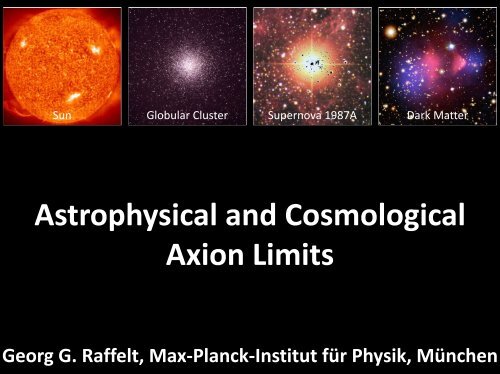

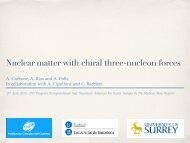
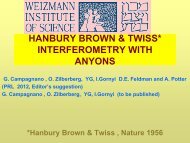
![Lecture 3 [pdf] - Institute for Nuclear Theory](https://img.yumpu.com/14762808/1/190x143/lecture-3-pdf-institute-for-nuclear-theory.jpg?quality=85)
